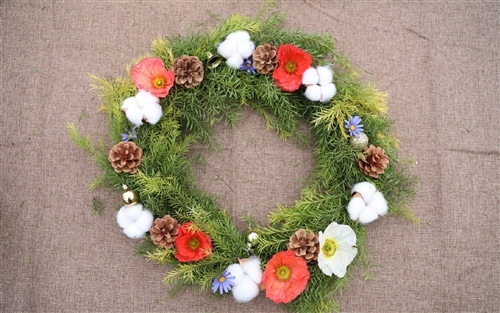
描写草莓外形的句子英语
strawberry The strawberry (Fragaria) is a genus of plants in the family Rosaceae, and the fruit of these plants. There are more than 20 named species and many hybrids and cultivars. The most common strawberries grown commercially are cultivars of the Garden strawberry, a Fragaria × ananassa hybrid. Strawberries are a valuable source of vitamin C.MorphologyThe strawberry is an accessory fruit; that is, the fleshy part is derived not from the ovaries (which are the seeds, actually achenes) but from the peg at the bottom of the hypanthium that held the ovaries. So from a technical standpoint, the seeds are the actual fruits of the plant, and the flesh of the strawberry is a vegetable. It is greenish-white as it develops and in most species turns red when ripe.The rosette growth of the plants are a well-known characteristic. Most species send out long slender runners that produce a new bud at the extremity. The leaves typically have three leaflets, but the number of leaflets may be five or one.While the flower has the typical rosaceous structure, the fruit is very peculiar, but it may be understood by the contrast it presents with the rose hip of the rose. In a rose the top of the flower-stalk expands as it grows into a vase-shaped cavity, the hip, within which are concealed the true fruits or seed-vessels. In the rose the extremity of the floral axis is concave and bears the carpels in its interior. In the strawberry, the floral axis, instead of being concave, swells out into a fleshy, dome-shaped or flattened mass in which the carpels or true fruits, commonly called pips or seeds, are more or less embedded but never wholly concealed. A ripe strawberry in fact may be aptly compared to the fruit of a rose turned inside out.Strawberries are now out of season.ClassificationThere are more than 20 Fragaria species worldwide. Key to the classification of strawberry species is recognizing that they vary in the number of chromosomes. There are seven basic types of chromosomes that they all have in common. However, they exhibit different polyploidy. Some species are diploid, having two sets of the seven chromosomes (14 chromosomes total). Others are tetraploid (four sets, 28 chromosomes total), hexaploid (six sets, 42 chromosomes total), octoploid (eight sets, 56 chromosomes total), or decaploid (ten sets, 70 chromosomes total).As a rough rule (with exceptions), strawberry species with more chromosomes tend to be more robust and produce larger plants with larger berries (Darrow).EtymologyThe name is derived from Old English streawberige which is a compound of streaw meaning straw and berige meaning berry. The reason for this is unclear. It may derive from the strawlike appearance of the runners, or from an obsolete denotation of straw, meaning chaff, referring to the scattered appearance of the achenes.Interestingly, in other Germanic countries there is a tradition of collecting wild strawberries by threading them on straws. In those countries people find straw-berry to be an easy word to learn considering their association with straws.There is an alternative theory that the name derives from the Anglo-Saxon verb for strew (meaning to spread around) which was streabergen (Strea means strew and Bergen means berry or fruit) and thence to streberie, straiberie, strauberie, straubery, strauberry, and finally, strawberry, the word which we use today. The name might have come from the fact that the fruit and various runners appear strewn along the ground.Popular etymology has it that it comes from gardeners' practice of mulching strawberries with straw to protect the fruits from rot (a pseudoetymology that can be found in non-linguistic sources such as the Old Farmer's Almanac 2005). However, there is no evidence that the Anglo-Saxons ever grew strawberries, and even less that they knew of this practice.
英语里关于草莓的谚语句子有什么
This is a strawberry. 这是草莓。
The color is red. 颜色是红色。
There are many black seeds on it. 在上面有好多黑色的籽。
It's very delicious to eat. 吃起来很美味。
So I like them. 所以我喜欢草莓。
英语关于草莓的小短文四五句话'
Hey, where's my sweater? It's a cool and windy day. I need a cap and sweater to go outside and play. Hey, where's my winter coat? It's a cold and snowy day. I need a coat, hat and gloves to go outside and play. Hey, where's my raincoat? It's a wet and rainy day. I need a raincoat and some boots to go outside and play. Hey, where's my swimsuit? It's a hot and sunny day. I need my suit and some sandals to go outside and play. When the seasons change, the clothes I wear change ,too No matter what the weather is, I play outside, don't you?
描写草莓的句子
不知道你指的是什么..不过这里很全..
描写草莓外形的一段话
草莓,又叫洋莓、地莓、地果、凤梨、红莓等,在园艺上属浆果类果树,学名Fragaia ananassa Duchesne。
原产欧洲,本世纪初传入我国而风靡华夏。
草莓外观呈心形,其色鲜艳粉红,果肉多汁,酸甜适口,芳香宜人,营养丰富,故有“水果皇后”之美誉。
蔷薇科,草莓属,多年生草本。
有匍匐枝,复叶,小叶3片,椭圆形。
初夏开花,聚伞花序,花白色或略带红色。
花托增大变为肉质,瘦果夏季成熟,集生花托上,合成红色浆果状体 草莓属蔷薇科多年生草本植物,又叫洋莓,原产于南美洲,我国是在20世纪初才引进的。
草莓品种繁多,有2000多个品种,果实鲜红美艳,柔软多汁,甘酸宜人,芳香馥郁,有“水果皇后”的美誉。
草莓营养丰富,富含多种有效成分,每百克鲜果肉中含维生素C60毫克,比苹果、葡萄含量还高。
果肉中含有大量的糖类、蛋白质、有机酸、果胶等营养物质。
此外,草莓还含有丰富的维生素B1、B2、C、PP以及钙、磷、铁、钾、锌、铬等人体必需的矿物质和部分微量元素。
草莓是人体必需的纤维素、铁、钾、维生素C和黄酮类等成分的重要来源。
草莓又叫红莓、杨莓、地莓等,是蔷薇科草莓属植物的泛称,全世界有50多种。
草莓营养丰富,含有果糖、蔗糖、柠檬酸、苹果酸、水杨酸、氨基酸以及钙、磷、铁等矿物质。
此外,它还含有多种维生素,尤其是维生素C含量非常丰富,每100克草莓中就含有维生素C60毫克。
草莓中所含的胡萝卜素是合成维生素A的重要物质,具有明目养肝作用。
草莓还含有果胶和丰富的膳食纤维,可以帮助消化、通畅大便。
草莓的营养成分容易被人体消化、吸收,多吃也不会受凉或上火,是老少皆宜的健康食品。
草莓的吃法很多。



